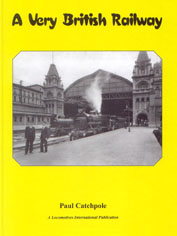A Very British Railway
by Paul Catchpole
- 84 pp, hardback, 125 b/w photos, 37 drawings, two maps
Disponível no Brasil através da:
Sociedade de Pesquisa
para Memoria do Trem
Caixa Postal 3136, Rio de Janeiro, RJ, 20001-970, Brasil
"Sendo importado pela Memória do Trem em permuta pelos nossos
livros com o editor, oferecemos no Brasil pelo mesmo preço especial
de nossos livros"
The engineers were Scottish, the early steam locomotives were built in
England and Scotland, the gauge was 5'3" as in Ireland, and the stations
and infrastructure would have appeared perfectly at home on any railway
of the pre-grouping period in Britain. Cowlairs-style inclines were constructed
to conquer a jungle-covered mountain range and were operated with steam
powered brake vans.
The British-owned São Paulo Railway carried coffee to the port
of Santos on Brazil's Atlantic coast and used Garratts for express passenger
haulage. It was a very British Railway indeed - but built in South America.
Even into the diesel and electric era the British influence remained
in evidence as Armstrong-Whitworth built express diesel railcars and English
Electric supplied the first main-line electric locos and e.m.u.s. Photographs
from enthusiasts who have visited this railway bring the story more up
to date with American-built diesels and electrics and the conversion to
rack haulage with Japanese-built electrics. Today the line is operated
by a freight company with leased diesels but part of the duplicated route
with steam-hauled inclines has been preserved and survives, including
winding engines and brake locomotives.
The inspiration for this book came from Trevor Rowe when he showed the
author an exceptional album of official photographs dating from
around 1920, which just begged to be seen by a wider audience. The
full story behind building this remarkable railway has since been
uncovered and more photographs of the line and its locomotives have
been traced. A number of regular 'Locomotives International' contributors
provided further information, in particular Reg Carter of the Stephen
Locomotive Society who assisted research by making available his
South American locomotive list and official São Paulo Railway
diagrams.
|
|

Locomotives International
Livros da SPMT
Livros importados
Sociedade de Pesquisa para Memória do Trem
|


